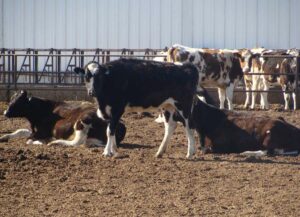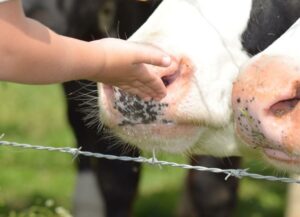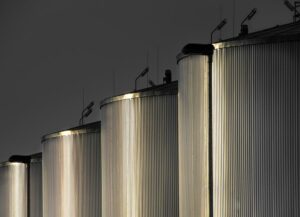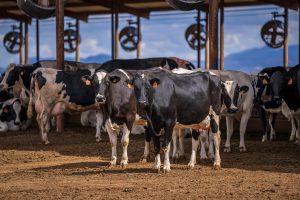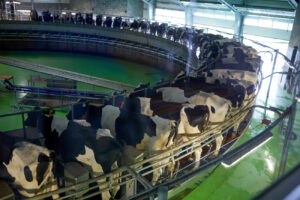Mercedes González & Nuria García
Bovine leukemia virus persistently infects cow lymphocytes with an infection that lasts throughout the life of the animal. In 70% of infected cows it does not cause disease and goes unnoticed (sub-clinical), but under some conditions, like when the immune status of the cow is compromised, this permanent infection can recur and produce a disease called enzootic bovine leukosis.
In many cases, clinical manifestations of bovine leukemia virus infection do not go beyond reductions in cow longevity or milk production. Regardless, it is a virus that produces large economic losses, especially because it is asymptomatic and goes unnoticed.
Some animals develop the disease under several forms. One is a persistent lymphocytosis (30% of cows), which consists of raising blood lymphocyte counts with virtually no other apparent symptoms. Some adult cows (about 0.5 to 1% of infected animals) usually 5 to 8 years of age develop a tumorous form or multicenter lymphosarcoma, which is fatal. In addition to causing mortality in sick animals, lymphosarcoma also results in economic losses from condemned carcasses at the slaughterhouse.
In some regions of the world, including the European Union and New Zealand, the disease is eradicated. However, it is still present on many farms in the US and is considered an infectious disease that causes significant economic losses and should be considered in control programs.
Transmission and detection of bovine leukemia virus
Bovine leukemia virus is transmitted between animals through blood and secretions containing infected cells; this is typically caused by sharing needles in vaccination procedures, serial blood extractions, arthropod bites (described in the US and Japan mainly during hot weather), and transmission through colostrum administration is also possible because of it being rich in white blood cells that contain the virus.
The detection of the disease is performed almost exclusively by serology in blood or milk samples. After becoming infected, cows develop a detectable degree of antibodies (seroconversion) around 2-8 weeks, although sometimes it can be up to 3 months. However, the results should be interpreted carefully, as antibody titles can fluctuate over time.
During lactation, cows are influenced by stressors that cause immunosuppression, with decreased dry matter intake and negative energy balance being the most important occurrences. Immunosuppression makes cows more susceptible to infections, including bovine leukemia virus. Immunosuppression can cause virus titles to drop during postpartum and the beginning of the lactation, as has been observed in some studies. In addition, lymphocyte counts fluctuate during the production cycle, including dry-off and at calving.
There are few studies that have quantitatively assessed how antibody titers against the bovine leukemia virus change, as well as lymphocyte counts throughout lactation, which would be very useful to improve detection, prevention, and diagnosis. A study (Wisnieski et al., 2020) set out to investigate how both parameters were modified starting at dry-off and during the transition period up to the beginning of lactation, and by parity. In order to perform this, the antibody titers against the bovine leukemia virus were measured at dry-off, at three weeks pre-calving and at 7-10 days in milk.
The prevalence of bovine leukemia virus infection increased from dry-off to pre-calving
At dry-off, the total percentage of positive cows (prevalence) was 38.9%, increasing to 43.6% pre-calving with a slight decrease to 43.0% at 7-10 days in milk. These results may indicate cows may have an increase in susceptibility to bovine leukemia virus infections due to the stress during drying. Another possible explanation for this increase in the prevalence at dry-off could be a normal increase in antibody concentration and not an indication of new infections; changes in antibody concentrations have been reported at dry-off and at the onset of the lactation (especially by the transfer to colostrum).
It was interesting to evaluate seroconversion, for example the percentage of cows that were negative to the virus at a given time but developed antibodies sometime later. In the interval between drying and pre-calving, 7.7% of cows that were negative became positive. In the period going from pre-calving to 7-10 days in milk, 3.6% of cows that were negative became positive. However, the outcome of the first period was not statistically significant, so it must be interpreted with caution.
When comparing the results by parity, the prevalence was 67.5% in third lactation, 41.5% in second lactation, and 25.3% in first lactation cows. The group of cows in third lactation was more likely to seroconvert than the rest; 21.4% went from negative to positive from dry-off to pre-calving compared to first [2.3%] and second lactation cows [9.1%]. This could be due to cumulative exposure of the cows to the virus over time. On the other hand, third lactation cows tended to have increased risk of cross-infections with other pathogens, as well as increased metabolic stress from increased milk production.
No statistically significant differences were observed in lymphocyte counts in the three periods in which samples were taken among cows positive for the virus. More in-depth studies would be needed to monitor the evolution of lymphocyte counts in relation to seroprevalence, parity, and the moment of the lactation, establishing more specific cut-off points.
Conclusions
This study concluded that the prevalence of bovine leukemia virus appears to increase from drying to pre-calving and that cows with higher lactation numbers were more prevalent and more likely to seroconvert during this period. Further studies would need to establish lymphocyte count monitoring measures and tools according to parity to assess infection status.
Reference
Lauren Wisnieski, Bo Norby, J. Gandy, T. M. Byrem, L. M. Sordillo. Changes in bovine leukemia virus serological status and lymphocyte count between dry-off and early lactation in Michigan dairy cows. Journal of Dairy Science. 2020 Oct; 103(10): 9473-9480.
© 2020 Dairy Knowledge Center. All Rights Reserved.


